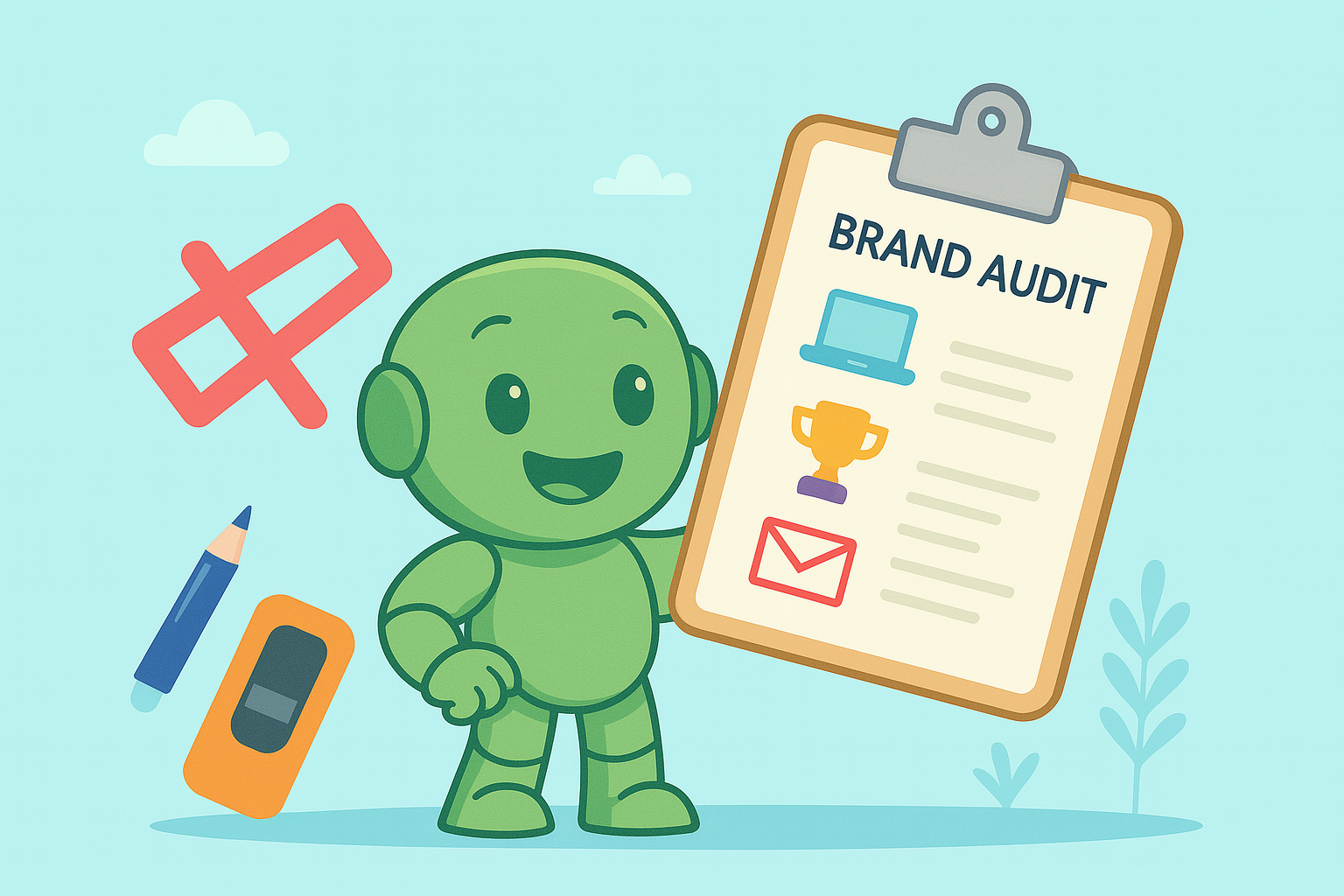Your Essential Brand Audit Template and Guide
Think of a brand audit as much more than a routine check-up. It's a strategic deep-dive into your company's identity and market position. Following a structured brand audit template gives you a reliable framework, making sure no critical insights get overlooked.
Why a Brand Audit Is Your Strongest Strategic Move

Before you jump into a template, it's crucial to grasp the immense value an audit delivers. It’s the process that shifts your brand strategy from guesswork to data-backed confidence.
The real magic of an audit is its ability to expose the gap between how you think your brand is perceived and how customers, employees, and the market actually see it. This reality check is the bedrock for building a stronger, more resilient brand.
To give you a quick snapshot, a comprehensive audit typically examines these core areas. We'll explore each one in more detail later, but this table provides a high-level overview.
Core Components of a Brand Audit
| Audit Area | What It Reveals |
|---|---|
| Internal Branding | How well your mission, vision, and values are understood and lived by your team. |
| External Branding | How customers perceive your brand through your messaging, visuals, and voice. |
| Customer Experience | The complete journey a customer takes with your brand, from discovery to post-purchase. |
| Competitive Landscape | Your brand's position relative to direct and indirect competitors in the market. |
| Digital Presence | Your brand's footprint across all digital channels, including social media, SEO, and website. |
This systematic approach is what makes an audit so powerful. It forces you to look at the whole picture, not just the pieces you're most comfortable with.
Pinpointing Gaps and Opportunities
An audit methodically combs through every facet of your brand—from your logo and messaging all the way to your customer service interactions. It’s this process that unearths the surprising inconsistencies that can quietly weaken your market standing.
For example, you might be marketing a premium, high-touch experience, but if your customer support feels rushed and impersonal, you’ve created a disconnect. This kind of friction erodes trust and can send customers straight to your competitors. A structured audit brings these contradictions into the open so you can tackle them head-on.
A brand audit isn’t about finding fault; it’s about finding clarity. It gives you the objective evidence you need to make smarter, more effective decisions about your brand's future and where to invest your marketing budget.
Maximizing Your Marketing Spend
In any competitive market, every dollar has to count, especially as advertising costs climb. In the UK alone, ad spend hit a record £36.6 billion in 2023, a stark reminder of the intense battle for consumer attention. A thorough audit is your best defense against wasted marketing spend.
A proper audit forces you to answer tough but essential questions:
- Are we actually reaching our ideal audience on the right channels?
- Does our messaging truly resonate and compel people to act?
- Is our brand name an asset or a liability for our growth?
Getting clear answers here stops you from pouring money into campaigns that just aren't working. The insights from a brand audit let you double down on what’s effective and refine what isn’t, directly improving your ROI. And if you're second-guessing the very foundation of your brand, it’s worth thinking about what you need to know about brand names to make sure yours is pulling its weight.
A Practical Walkthrough of the Brand Audit Template
Alright, theory is great, but let's get our hands dirty. A good brand audit template isn't just another spreadsheet to fill out; it's a thinking tool. It’s designed to guide you from the 30,000-foot view of your strategy right down to the nitty-gritty details of a single social media post.
Let's break down how to use it, section by section. We’re not just going to cover what to document, but explore why each piece of information is so critical for building a stronger brand. Think of it less like a checklist and more like a guided journey to strategic clarity.
Defining Your Business Core
First things first, you have to nail down the absolute fundamentals of your business. This isn't about reciting corporate mission statements from a dusty employee handbook. It's about articulating the very soul of your company—the north star that should guide every single decision you make.
Your template will prompt you to define these key elements:
- Purpose: Beyond making a profit, why do you exist? This is your "why." For a local coffee roaster, the purpose might be "to build community and connection, one cup at a time."
- Vision: What does the future look like if you succeed beyond your wildest dreams? This is your long-term, aspirational goal. For that same roaster, it could be "a city where every neighborhood is anchored by a welcoming coffee shop that sources ethically."
- Mission: What are you doing right now to make that vision a reality? This is your practical, day-to-day objective. For instance: "to source, roast, and serve the highest-quality single-origin coffee while creating a warm, inclusive space for our neighbors."
When you write these down, you're forced to confront whether your actions actually match your words. Is your mission to build community, but your shop’s layout discourages people from lingering? The audit brings that kind of disconnect to the surface immediately.
A powerful brand audit doesn't just look at your marketing. It puts your entire business strategy on trial to see if every action, every product, and every interaction genuinely supports your core purpose. This is where real brand authenticity comes from.
A solid template will guide you through this, covering everything from your business purpose and values to a deep dive into your target audience. You'll also find sections for competitive analysis and an honest look at your brand's personality and messaging. To see how these pieces all fit together in a real-world document, check out this complete brand audit template example.
Assessing Your Visual and Verbal Identity
Once your strategic foundation is solid, it's time to look at what your customers actually see and hear. This is all about your external-facing brand elements—and where consistency is king.
The image below breaks down the key pieces of a brand's visual identity. It’s a great reminder of how your logo, colors, and even your fonts work together to create a recognizable and cohesive experience.
Your template is the perfect place to document and critique each of these building blocks. Don’t just list them; question them.
Here’s what you should be digging into:
- Logo and Usage: Is your current logo being used everywhere, consistently? Or is that old, pixelated version from 2015 still lurking on a forgotten LinkedIn profile? Hunt it down.
- Color Palette: Do your colors send the right message? A wealth management firm trying to convey trust and stability probably shouldn't be using the neon pinks and yellows of a candy brand.
- Typography: What do your fonts say about you? A clean, modern sans-serif font can feel sleek and approachable, while a traditional serif font might suggest heritage and authority.
- Brand Voice and Messaging: How do you actually sound? Are you formal and expert-driven, or are you witty, casual, and a little bit irreverent? Document your core messages and then go check if they’re being used consistently across your ads, website copy, and even your customer service chats.
By systematically holding these elements up against your core purpose, you’ll quickly spot the inconsistencies that are confusing customers and watering down your brand's power. This is what makes a brand audit template more than just a document—it’s an indispensable strategic weapon.
How to Conduct Your Internal Brand Audit
A powerful brand isn’t just built with clever marketing campaigns; it’s forged from the inside out. Your employees are your very first audience and, when you get it right, your most passionate advocates. The internal audit is where you make sure the brand they live and breathe every day is the same one you’ve so carefully defined on paper.
This part of the process turns the lens inward. It's all about examining how your brand is understood, perceived, and ultimately lived by your own team. Think of it as a health check for the alignment between your stated values and your actual company culture.
Assessing Culture and Employee Alignment
Your company culture is the living, breathing expression of your brand. If you preach collaboration but your internal processes are siloed and hyper-competitive, you've got a major brand disconnect. The internal audit is your chance to measure that gap.
To get an honest assessment, you have to create a safe space for candid feedback. Anonymous surveys are a fantastic tool here, as they allow team members to share their genuine thoughts without any fear of reprisal.
Consider asking questions like:
- On a scale of 1-10, how well do you feel our day-to-day work reflects our company’s core values?
- Can you easily describe our brand’s mission to a friend?
- Do you feel you have the right tools and training to be a great ambassador for our brand?
The goal is to move beyond just awareness. What you're really after is true brand advocacy. Are your employees just collecting a paycheck, or do they feel like they’re part of something meaningful?
An internal audit isn't about policing your team. It's about empowering them. When employees are aligned with the brand's mission, they become your most authentic and powerful marketing asset.
Team workshops are another great way to dig deeper. These sessions can uncover nuanced insights that surveys often miss, revealing how different departments see the brand and their role in bringing it to life. This is also a perfect opportunity to perform some hands-on analysis of your core identity. For a complete picture, check out our comprehensive guide on how to conduct brand name testing with your internal teams.
Reviewing Internal Brand Assets
Once you have a handle on sentiment, it's time to review the tangible assets that shape your team's understanding of the brand. This is a practical, no-nonsense review of your internal communications and resources, all of which should be covered in your brand audit template.
Start by gathering and analyzing these key materials:
- Onboarding materials: Do new hires get clear, compelling information about the brand’s purpose and values from day one?
- Internal brand guidelines: Are they accessible, easy to understand, and actually used? Or are they just a dusty PDF lost on a shared drive?
- Company-wide communications: Do all-hands meetings, newsletters, and intranet posts consistently reinforce the brand’s voice and priorities?
Look for the inconsistencies. If your guidelines call for a friendly, approachable tone, but internal memos are formal and stuffy, it creates confusion. Every piece of internal content is an opportunity to strengthen brand alignment. By getting your internal house in order, you build a solid, authentic foundation before you ever face the customer.
Mastering the External Brand Audit
Once you’ve looked inward, it’s time to turn your attention to the outside world. This is where you get to see your brand through the eyes that matter most: your audience's. An external brand audit is all about how your company shows up in the market, giving you the unfiltered truth about your reputation, visibility, and where you stand against the competition.
This part of the process forces you to move beyond internal assumptions and get your hands on real-world data. It's a systematic evaluation of every single place a potential or current customer might interact with your brand. Think of it as mapping your brand’s public footprint to see if the path leads where you intend it to.
Measuring Brand Awareness and Reputation
You can't fix what you don't measure. The first order of business in an external audit is getting a clear baseline of how visible and well-regarded your brand actually is. This requires a smart mix of hard numbers and qualitative feedback.
Your digital presence is the natural starting point. Dig into your website analytics and SEO performance. Look at where your traffic is coming from, how people behave once they arrive, and where you rank for crucial industry search terms. For example, a high bounce rate on your homepage might be a red flag that there's a disconnect between your ad copy and your landing page experience—exactly the kind of critical insight an external audit is designed to uncover.
From there, shift your focus to social media. And I don’t just mean tracking likes and follower counts. True social listening means tuning into the conversations happening about your brand, your competitors, and your industry as a whole.
- Sentiment Analysis: Are people speaking about your brand in a positive, negative, or neutral light? Certain tools can automate this, giving you a quick snapshot of public opinion.
- Share of Voice: In the online chatter within your niche, what percentage of the conversation belongs to you versus your competitors? This is a powerful indicator of brand visibility.
- Key Themes: What words or ideas are people constantly associating with your brand? This tells you what your audience thinks you stand for, which may or may not align with your goals.
Pulling these metrics together helps you build a comprehensive picture of your brand's health in the wild. You’re essentially using these methods to see how you measure up, from customer perception to brand consistency. If you want to dive deeper, you can discover more insights on how to measure your brand's presence on Brand24.
Reviewing Customer-Facing Touchpoints
Consistency is the absolute bedrock of a strong brand. Every single interaction a customer has with your business should feel like it comes from the same place and is aligned with your core identity. This is where a good brand audit template becomes your best friend, allowing you to review these touchpoints methodically.
Make a checklist and be brutally honest as you evaluate each item:
- Website: Is the user experience intuitive and smooth? Is the messaging clear, persuasive, and free of jargon?
- Social Media Profiles: Are all your profiles complete, visually on-brand, and updated regularly with valuable content?
- Sales Collateral: Do your brochures, proposals, and sales decks reflect your current brand positioning and messaging?
- Customer Service: How do your support agents sound? Is their tone and language aligned with the brand voice you’ve carefully defined?
Imagine a SaaS company that markets itself as innovative and user-friendly, but its website looks like it’s stuck in 2010. That kind of glaring inconsistency doesn't just look bad; it actively erodes credibility and confuses potential customers. This is precisely the type of problem an external audit is built to find and fix.
Conducting a Competitor Analysis
Let's be real: no brand exists in a vacuum. To carve out a unique and defensible spot in the market, you have to know where you stand in relation to everyone else. And this analysis needs to be more than just a quick peek at their homepage.
You need to dig deep into their strategy. Sign up for their newsletter. Follow them on social media. If you can, go through their customer journey yourself—buy their product or book a demo. As you do this, ask yourself some tough questions:
- How are they positioning themselves? Are they the budget-friendly choice, the premium luxury option, or the specialist for a tiny niche?
- What does their brand voice sound like? Is it witty and informal, or is it more formal and authoritative?
- Where are their biggest strengths and most obvious weaknesses? Maybe their product is fantastic, but you’ve heard their customer service is painfully slow.
This kind of deep-dive investigation is what reveals the gaps in the market—and the golden opportunities for you to differentiate. By truly understanding how your competitors are seen, you can position your own brand to win over the exact customers you’re trying to attract. This outside perspective is what turns a pretty good brand into an unforgettable one.
From Audit to Action: Building Your Brand's Future Strategy
All that work—the data deep dives, the customer surveys, the competitor teardowns—it all leads to this moment. An audit is just a collection of facts until you use it to make smart decisions. Now's the time to translate those insights from your brand audit template into a real, tangible plan for growth.
The first thing I always do is get everything organized. A classic SWOT analysis (Strengths, Weaknesses, Opportunities, Threats) is perfect for this. You're essentially taking all the puzzle pieces from your internal and external research and sorting them into four buckets. It’s a beautifully simple way to see everything in one place.
For instance, maybe you discovered your team is incredibly passionate about your mission—that's a huge Strength. On the flip side, if your website looks like it's from 2005 and doesn't work on phones, that’s a glaring Weakness. This exercise cuts through the noise and gives you a clear, high-level view of where you stand.
How to Prioritize Without Getting Overwhelmed
With a completed SWOT, you’ll probably be staring at a monster list of potential projects. Don't panic. The secret here is ruthless prioritization. You can't fix everything at once, and frankly, not everything needs fixing right away.
Your job is to find the initiatives that will make the biggest difference, fast. A major issue with how customers perceive your brand is a fire you need to put out immediately. That takes priority over, say, tweaking the tone of your social media bios.
I find a simple impact/effort matrix works wonders here. Just score each potential project on two scales:
- Impact: How much will this move the needle for our brand or our bottom line? (Score 1-5)
- Effort: How much time, money, and people-power will this take? (Score 1-5)
Zero in on the high-impact, low-effort items first. These are your quick wins that build momentum. After that, start planning for the high-impact, high-effort projects; these often become your big strategic pillars for the next quarter or year.
Creating Your Strategic Roadmap
Once you know your priorities, it's time to build a formal roadmap. This is where you move from "what" we need to do to "who" is doing it, "when" it will get done, and "how" we'll do it. It’s the blueprint for your brand's next chapter.
For every major initiative you've prioritized, flesh it out with these details:
- A Clear Objective: Be specific. "Improve our messaging" is too vague. Try something like, "Refine our core brand message to clearly highlight our commitment to sustainability."
- Key Performance Indicators (KPIs): How will you know if you've succeeded? Define your metrics upfront, like aiming for a 15% increase in website conversions or a 20% jump in positive online brand mentions.
- An Owner: Make someone accountable. A single person or a dedicated team needs to own the initiative from start to finish.
- A Timeline: Set realistic deadlines. When does the project kick off, and when will it be completed?
This structure turns a fuzzy idea into a concrete plan. For example, if your audit showed your visual identity was all over the place, your roadmap might include a full brand identity redesign. If you find yourself in that boat, learning more about creating a brand identity can be a great next step. By following this process, you ensure your brand audit doesn't just sit in a folder—it becomes a powerful engine for real, strategic change.
Common Questions About Brand Audits
Even with a detailed guide and a great brand audit template, you're bound to have some questions. That’s completely normal. Let's tackle a few of the most common ones I hear from teams diving into this process for the first time.
How Often Should We Really Do This?
This is probably the number one question I get. While there’s no single magic number, a good rule of thumb is to perform a full-scale audit every 12-24 months. This cadence is usually frequent enough to keep your strategy in sync with market changes without overwhelming your team.
Of course, sometimes you can't wait for the annual review. Certain events should trigger an audit immediately, no matter when your last one was. Think of these as critical moments that demand a brand check-up:
- A major business pivot: This could be a merger, an acquisition, or a significant shift in your core strategy.
- Entering new territory: Are you launching in a new country or introducing a flagship product? It's time to audit.
- Alarm bells are ringing: If you see a sustained drop in sales, market share, or customer loyalty, an audit can help you find out why.
- A PR nightmare: A public crisis or a flood of negative feedback is a clear sign that you need to assess your brand's standing.
What if Our Team and Our Customers See the Brand Differently?
Discovering that your internal team views the brand one way, while customers see it as something else entirely, can be jarring. But honestly, this is one of the most valuable insights an audit can uncover.
When you find this kind of disconnect, don't panic or try to dismiss one side. What you've found is gold. Your internal perception is your brand identity—what you want to be. The customer's perception is your brand image—what you actually are in the market. The space between those two is your opportunity.
Your job isn't to prove who's "right." The real work is in understanding why that gap exists and then building a clear, actionable plan to close it. This means aligning your internal culture, your marketing messages, and your customer experience.
How Do I Get Leadership to Approve This?
Getting buy-in from the C-suite can feel like a tough sell. Executives are wired to think about the bottom line, and they'll want to see a clear path from a brand audit to real business results. So, you have to speak their language.
Forget talking about abstract concepts like "brand consistency" or "improving our voice." Instead, frame the audit around metrics they care about.
For example, pitch it like this:
- "This audit will help us clarify our value proposition, which can reduce customer acquisition costs."
- "By aligning our messaging, we can increase customer engagement and loyalty, directly impacting lifetime value."
Position the brand audit not as a simple marketing expense, but as a strategic investment in the company's future growth and profitability. If you have any preliminary data, use it. Show them how a stronger brand leads to tangible outcomes like higher market share or the power to command premium pricing. When you connect the audit to ROI, you’re far more likely to get the green light.
Ready to stop guessing and start building a more powerful brand? The NameRobot platform provides the tools you need to not only find the perfect name but also to test and strengthen your brand's foundation.















